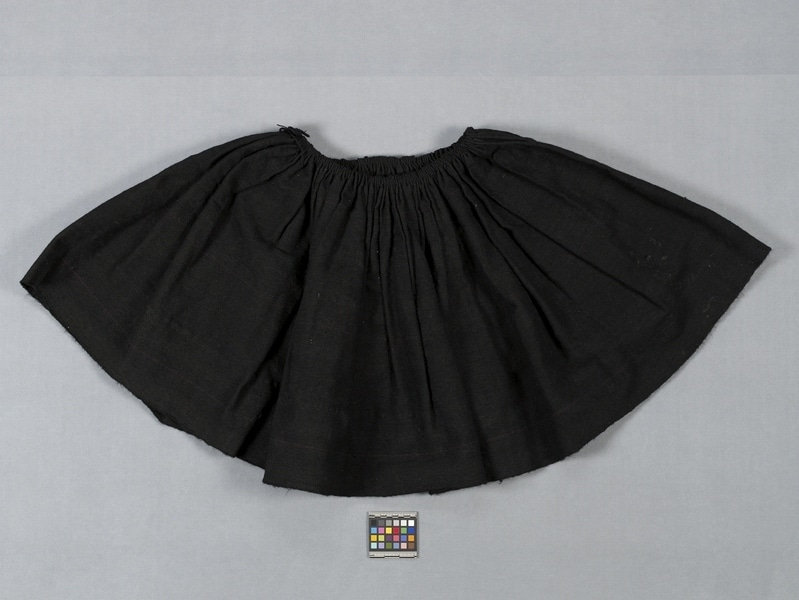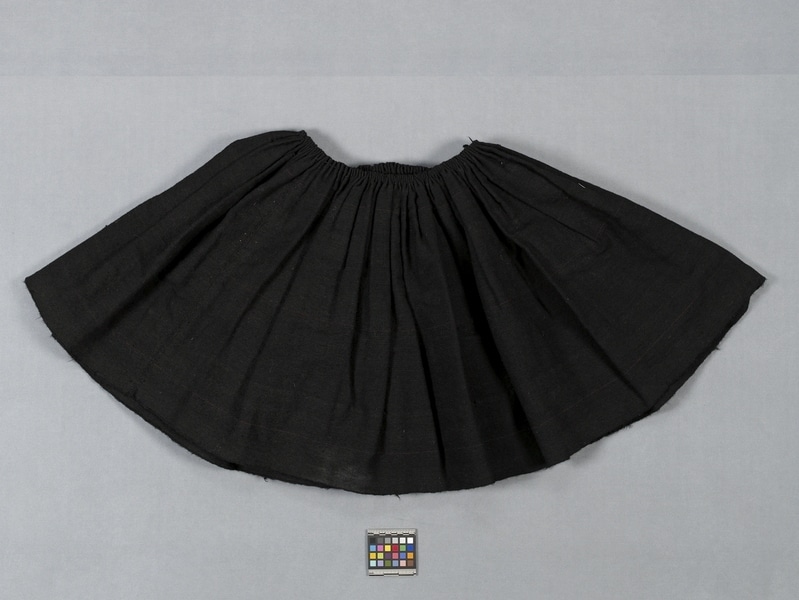Over Skirt Item Number: Sf383 from the MOA: University of British Columbia


Description
Over skirt made from black wool. The skirt is wide at the bottom and gathered with a black cord at the waist. Three fine red lines are widely spaced and run horizontally around the skirt. The lower edge is overcast with a shiny black yarn and the single length of fabric is joined together with one seam.
History Of Use
Warp-faced fabric with three or four selvedges are woven by women but the fabrics are used by both sexes. The techniques, structures and some of the motifs have pre-Conquest antecedents. This type of textile conveys the most information about an individual's ethnicity, sex, age, status and particular history. The aksu or overskirt is rarely worn today and few girls make them anymore. Wives of community officials and a few old women still wear them. In the past, girls in their mid-teens would spin and weave an aksu for themselves prior to their marriage. An aksu was worn with a 'tipana' or black bodice of similar material over a white wool blouse. Today most women wear skirts of a looser woven material sewn from fabric woven by men on treadle looms.
Narrative
Dionisia spun and wove the aksu material about ten years ago while she was a teenager. Even then, few girls put the labour into making this time-consuming garment. She has worn it only on a few occasions for church and for visits to the mainland town of Puno. Other women are very admiring of a good aksu and check the fineness of the spinning, the evenness of the weave and the amount of fabric in assessing it.
Specific Techniques
Warp yarns are constructed from one strand of z spun alpaca and one strand of z spun sheep's wool, plied 2-s. Weft is z-2s wool yarn. Yarns are dyed after spinning and plying but before the yarns are retwisted to give them a hardwearing surface. Fabric is warp-faced plain weave. Skirt is constructed from one piece of fabric with four selvedges. The warp selvedges are joined into a seam by inserting a sewer cord into the warp loops of one selvedge and then the other. Waist is gathered and lower edge is overcast by hand.
Item History
- Made by Dionisia Marca Quispe (Maker) in Taquile, Puno, Peru between 1975 and 1979
- Collected by Mary Frame during 1987
- Owned by Dionisia Marca Quispe
- Owned by Mary Frame before November 3, 1987
- Received from Mary Frame (Seller) and Museum of Anthropology Shop Volunteers (Funding source) on November 3, 1987
What
- Name
- Over Skirt
- Identification Number
- Sf383
- Type of Item
- skirt
- Material
- wool fibre, alpaca wool fibre and dye
- Manufacturing Technique
- spun, woven, dyed and plied
- Overall
- height 67.5 cm, width 132.0 cm, depth 5.0 cm
Who
- Culture
- Quechua
- Creator
- Dionisia Marca Quispe (Maker)
- Field Collector
- Mary Frame
- Previous Owner
- Dionisia Marca Quispe and Mary Frame
- Received from
- Mary Frame (Seller) and Museum of Anthropology Shop Volunteers (Funding source)
Where
- Holding Institution
- MOA: University of British Columbia
- Made in
- Taquile, Puno, Peru
When
- Creation Date
- between 1975 and 1979
- Collection Date
- during 1987
- Ownership Date
- before November 3, 1987
- Acquisition Date
- on November 3, 1987
Other
- Item Classes
- textiles
- Condition
- good
- Accession Number
- 1274/0001